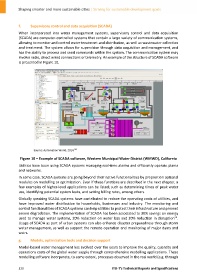Page 530 - Shaping smarter and more sustainable cities - Striving for sustainable development goals
P. 530
f. Supervisory control and data acquisition (SCADA)
When incorporated into water management systems, supervisory control and data acquisition
(SCADA) are computer‐controlled systems that contain a large variety of communication systems,
allowing to monitor and control water treatment and distribution, as well as wastewater collection
and treatment. The system allows for supervision through data acquisition and management, and
has the ability to process and send commands within the system. The communication system may
involve radio, direct wired connections or telemetry. An example of the structure of SCADA software
is presented in Figure 10.
29
Source: Automation World, 2014.
Figure 10 – Example of SCADA software, Western Municipal Water District (WMWD), California
Utilities have been using SCADA systems managing real‐time alarms and efficiently operate plants
and networks.
In some case, SCADA systems are going beyond their native functionalities by proposition optional
modules on modelling or optimization. Even if these functions are described in the next chapter, a
few examples of higher‐level applications can be listed; such as determining times of peak water
use, identifying potential system leaks, and setting billing rates, among others.
Globally speaking SCADA systems have contributed to reduce the operating costs of utilities, and
have improved water distribution to households, businesses and industry. The monitoring and
control functionalities of SCADA systems can help utilities to protect their infrastructure and prevent
severe degradation. The implementation of SCADA has been associated to 30% savings on energy
30
used to manage water systems, 20% reduction on water loss and 20% reduction in disruption .
Usage of SCADA as part of urban systems can also enhance disaster preparedness through storm
water management, as well as support the remote operation and monitoring of major dams and
weirs.
g. Models, optimization tools and decision support
Model‐based water management has evolved over the years to improve the quality, quantity and
operations costs of the global water supply through comprehensive modelling applications. These
modelling software incorporate, to some extent, processes observed in the real world (e.g. through
520 ITU‐T's Technical Reports and Specifications

